Disposable Nitrile Gloves vs Latex vs Vinyl [Complete Guide]
Say you’re shopping online for disposable gloves.
There’s an overwhelming number of choices out there. Nitrile or latex? How about vinyl? Powder-free or no? Which gloves are best for your industry?
Not to worry. This comprehensive guide will go through:
- the types of disposable gloves available (nitrile, latex, and vinyl)
- the pros and cons of each
- glove uses and quality standards they should be meeting
- and what's best for your line of work.
Let’s get started.
Nitrile Gloves: An Introduction
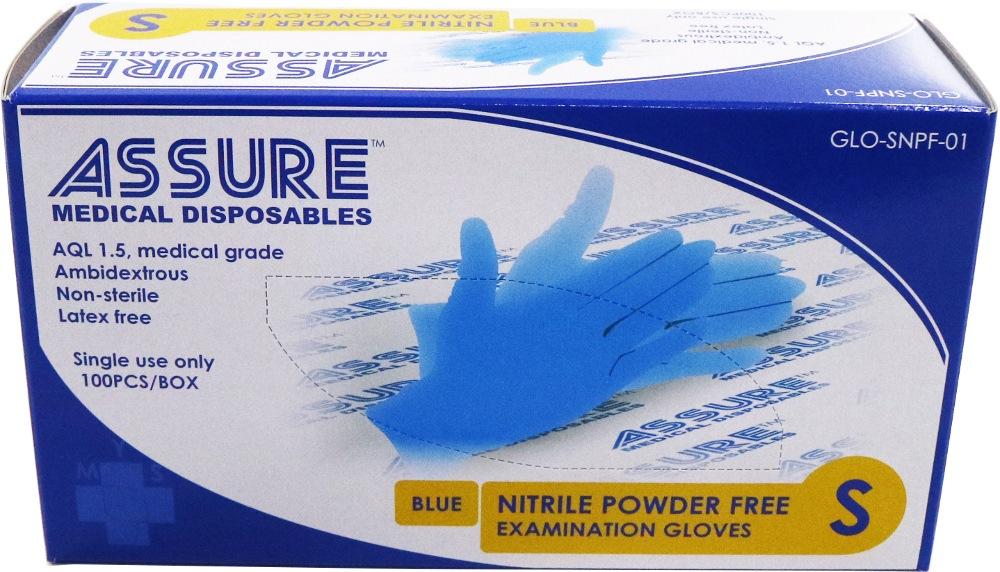
If you’re a frontline worker or healthcare professional, you may have heard of the nitrile glove shortage. Skyrocketing demand during COVID-19 sent prices up by 967%, from $3 to $32 for a box of 100. Now that we’re in the second year of the pandemic, the shortage (and high prices!) seems likely to continue.
But What’s Nitrile Anyway?
Nitrile rubber (NBR) is a synthetic rubber developed in controlled laboratory conditions. It's the culmination of research that took place between and during the two world wars. Nitrile combines two monomers (acrylonitrile and butadiene) in a process called copolymerisation to form the base material. It's most useful for situations requiring high oil resistance, such as in automotive seals, gaskets, and other items exposed to hot oils.
What’s Good About Nitrile Gloves?
Nitrile gloves are waterproof, greaseproof, heat-resistant, and chemical-resistant. Medical professionals and higher-risk industries prefer them because of their durability: they’ve got high abrasion, puncture, and snag resistance, which means they’re less likely to rip during use.
Nitrile gloves are also preferable because they’re hypoallergenic. This does not guarantee that you won’t have any allergic reactions though, as the chemical compounds in some gloves can still cause skin allergies.
On top of that, nitrile gloves are snug-fitting and mould to the shape of your hand, giving you more dexterity to perform intricate tasks. Coupled with its ability to limit static discharge, nitrile is the glove of choice for professions where a stray charge may be dangerous (e.g. electricians working with conductive metals, doctors administering cardiac defibrillation).
Certain black nitrile gloves have low sweat technology as well, so they’re comfortable to wear outdoors or for long periods of time. And the fact that nitrile gloves are available in non-medically-associated colours like black and orange makes them popular with tradesmen, who prefer disposable gloves with a sleek look.
Lastly, nitrile gloves typically have a higher shelf life than latex gloves. The former can usually last five years, whereas natural latex has a shelf life of three years. Just note that you should be storing your nitrile gloves out of the heat and direct sunlight.

Okay, What About the Bad?
Well, nitrile actually has a lot of strengths and few weaknesses — hence its popularity.
Aside from the exorbitant prices COVID-19 profiteers will charge you for nitrile gloves, here’s a few of the cons:
- Most nitrile gloves aren’t biodegradable. When demand for disposable gloves went up severalfold during the pandemic, this created heaps of medical waste — not to mention the extra litter. Certain manufacturers do sell biodegradable nitrile gloves, but they still take a lot longer to decompose than natural latex.
- They’re not as elastic or as flexible as latex gloves. They’ve still got a bit of springiness to them because they’re synthesised from natural rubber, but nitrile has a higher chance of breaking when overstretched.
- Not all nitrile gloves are food-grade. Admittedly this applies to disposable gloves in general, but it’s a common misconception that all nitrile gloves are fine for food prep. It’s best to check that the gloves you buy are compliant with industry requirements.
Latex Gloves: An Introduction
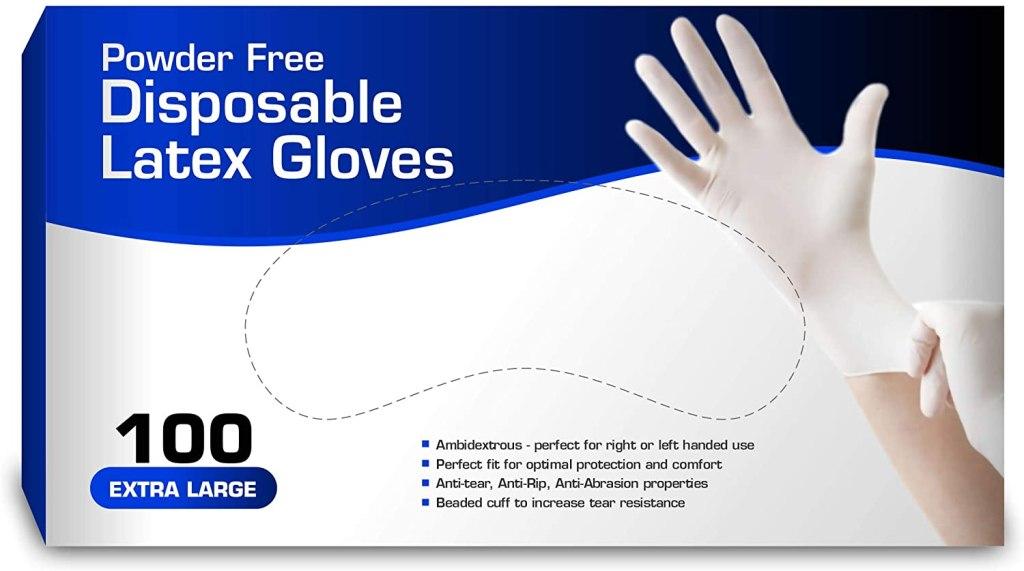
Ahh, latex...the natural alternative to nitrile. While latex and rubber are often used synonymously, they’re not exactly the same.
So What’s Latex Then?
Latex is a naturally-occurring substance that plants create as protection against insects. When the plant is injured, it secretes latex to seal the cut and prevent further attacks. While the most well-known source of latex is the rubber tree, you can actually find it in about 10% of all plants.
For decades, latex was the disposable glove of choice for healthcare institutions all over the world because of its cost-effectiveness, elasticity, and second-skin feel.
What Else Is Good About Latex?
Latex offers decent protection against a number of chemicals, though not as high or as wide a range as nitrile. (See chart) It’s also good against bloodborne pathogens, bacteria, and viruses — provided the latex gloves are medical-grade. (One study revealed that 30% of all latex gloves are not impermeable against bacteria and viruses.)
The elasticity of latex means it’s durable, flexible, and has better tear resistance compared to nitrile. And because it usually fits wearers like a second skin, it offers you better dexterity for sensitive or intricate procedures.
Natural latex gloves are biodegradable for the most part and can be composted as long as they’re uncontaminated. This is preferable particularly for healthcare institutions and food preparation businesses, which are by far the biggest consumers (and waste-makers) of disposable gloves.
Latex gloves offer good to excellent protection against household detergents and bleach, making them an attractive option for the cleaning industry.
Because latex gloves are cheaper than nitrile, they’re generally considered a cost-effective option for professionals who require glove protection for a limited period of time (say, for a medical examination).
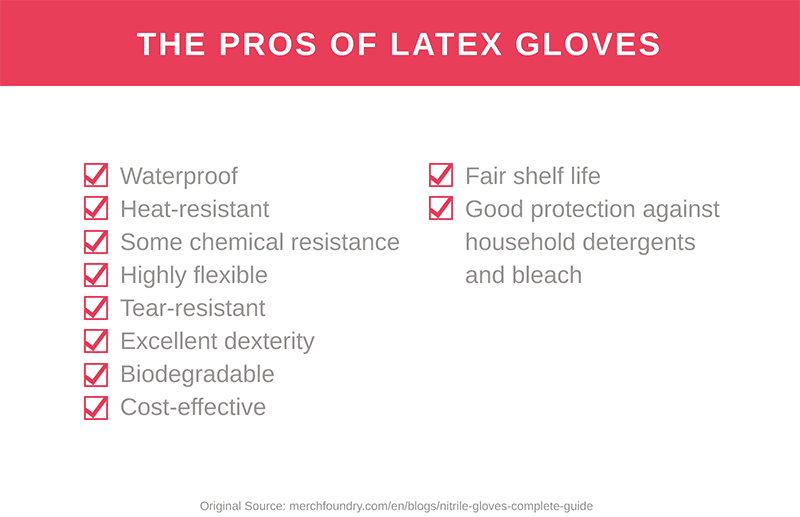
What’s Bad About Latex?
Latex gets a bad rap for the severe allergic reactions it causes. It’s true that latex is the most common culprit for glove allergies — and just as true that latex allergies are the most serious because they can cause anaphylactic shock.
But just because you’re using nitrile or vinyl doesn’t mean you can avoid allergic reactions altogether. Often, the compounds in nitrile and vinyl gloves can cause chemical allergies as well.
That said, many medical and food prep facilities have moved away from using latex gloves because of the higher incidence of latex allergies. Even if you’re not wearing the gloves yourself, eating food prepared by someone wearing latex gloves may trigger the allergies.
Latex gloves are inherently static insulative. This means they hold on to an electrostatic charge and then release it in an uncontrolled manner. In cases where this electrostatic discharge (ESD) could cause harm to people or damage to products, disposable latex gloves are not advisable.
Compared to nitrile gloves, latex has a lower puncture resistance and lower shelf life of three years. They’re not meant to be worn for a long time either; one study found that after just 12 minutes of simulated clinical use, natural latex glove defect rates increased to 9%.
Vinyl Gloves: An Introduction
If you’ve ever had lunch in a cafeteria or fast food restaurant, it’s likely that your food was prepared by someone wearing vinyl gloves. That’s because food services tend to prefer these low-cost gloves, which also happen to have a long shelf life.
That said, while disposable gloves in general aren’t great for the environment (or our health), vinyl is probably one of the worst offenders as certain brands contain toxic plasticizer chemicals — a chemical that's necessary to make the gloves flexible.
What’s Vinyl?
Vinyl is a petroleum-based film also known as PVC — yes, the same underlying material used to create your pipes. It’s inexpensive to synthesise (and therefore cheap for buyers), so it serves as a good option when handling products that require some protection and frequent glove changes.
Is There Anything Good About Vinyl Gloves?
The main benefit of vinyl gloves is that they’re cheap. They’re loose-fitting and lightly powdered so they’re easy to put on, though there are also powder-free versions. They’re best suited for relatively quick, low-risk tasks that don’t require a lot of tactile sensitivity or dexterity.
Some would say that another perk of vinyl is that it’s a latex-free option for those with latex allergies.
Vinyl actually has the best electrostatic dissipation properties of the three disposable glove types. This means that any electrostatic charges flow to ground more slowly and in a more controlled manner, so they’re recommended for cleanroom applications where there’s little need for bacterial protection.
Vinyl gloves offer fair resistance to fish products, vegetable oils, brake fluid, and gasoline. They resist sulfuric acid better than both nitrile and latex gloves, and are good protection against household detergents and bleach.
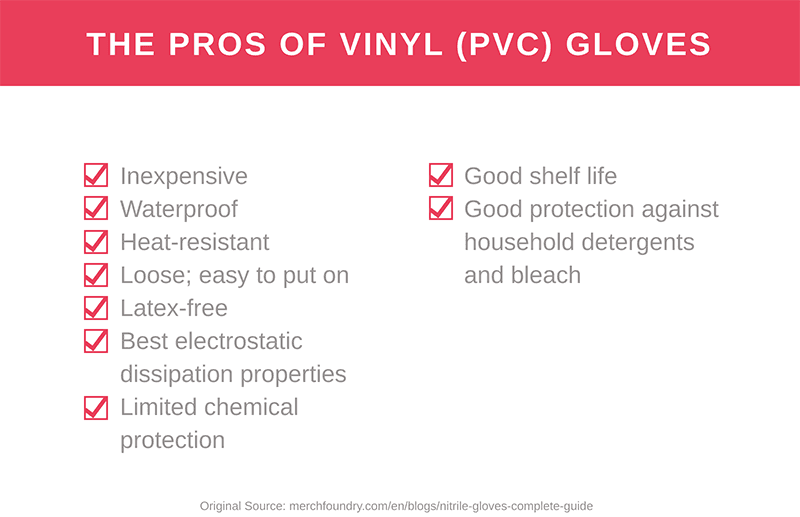
Okay, What’s Bad About Vinyl Gloves?
Sadly, the easy breakability of vinyl gloves limits their usefulness. Because the material isn’t very elastic, they can break with a simple finger press — or by catching on one of your nails.
Vinyl gloves snag and puncture easily, leaving you vulnerable to microbiological or chemical risks. Then again, you probably don’t want to be wearing these gloves if there are any hazardous chemicals around, as these don’t offer much in the way of chemical protection.
Vinyl also isn’t great with prolonged contact with fatty foods, as fat degrades the material. And the loose fit means they can compromise your dexterity and be uncomfortable to wear. They’re not meant for longer-duration or higher-risk tasks.
Nitrile, Latex, or Vinyl Gloves: Which One is Best?
That really depends on how long you’ll be using the glove for and what you (and the product or patient) require protection against.
For example, medical examinations are often short, lasting only a few minutes. The gloves are discarded and replaced between each patient appointment. But healthcare facilities are also a high-risk environment for biological, virus, or chemical contamination, so adequate protection is necessary.
Here’s a quick rundown of the characteristics of each disposable glove to help you decide:
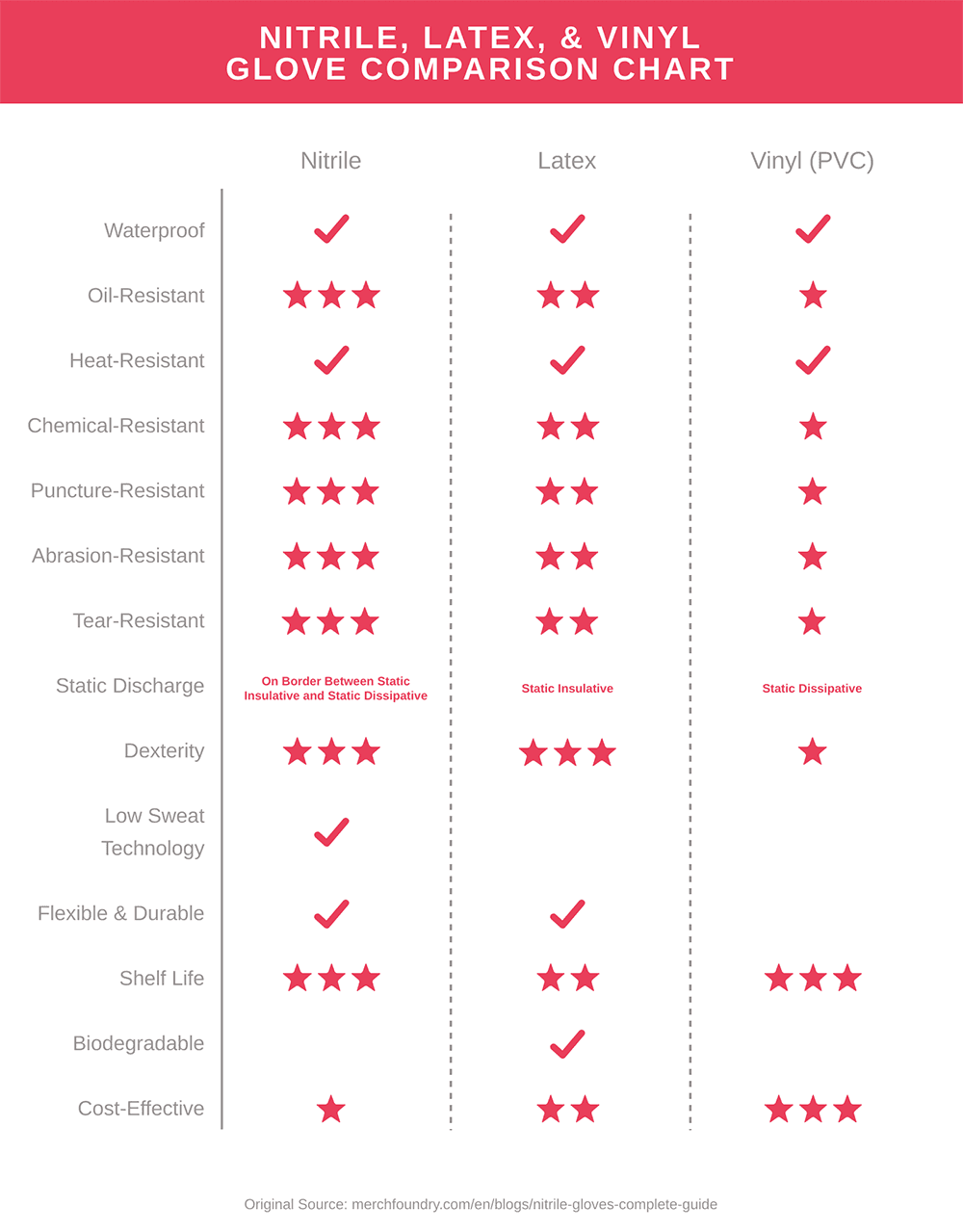
Across the board, nitrile gloves offer the best overall protection along with their hypoallergenic properties. Not only do they offer broad chemical resistance, but the greater dexterity, durability, and comfort they afford also increase productivity and safety.
But if you’re purchasing nitrile gloves, you’ll still want to make sure you go for an option that meets the regulatory requirements for your industry.
For example, the Food & Drug Administration in the US has banned powdered gloves because of the risk of illness and injury the powder poses.
In the European nations, disposable gloves used in food preparation must be EN1186-compliant, which restricts the materials and the trace amounts of plastic that may be released into the food.